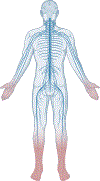Towards prevention of diabetic peripheral neuropathy: clinical presentation, pathogenesis, and new treatments
- PMID: 36115364
- PMCID: PMC10112836
- DOI: 10.1016/S1474-4422(22)00188-0
Towards prevention of diabetic peripheral neuropathy: clinical presentation, pathogenesis, and new treatments
Abstract
Diabetic peripheral neuropathy (DPN) occurs in up to half of individuals with type 1 or type 2 diabetes. DPN results from the distal-to-proximal loss of peripheral nerve function, leading to physical disability and sometimes pain, with the consequent lowering of quality of life. Early diagnosis improves clinical outcomes, but many patients still develop neuropathy. Hyperglycaemia is a risk factor and glycaemic control prevents DPN development in type 1 diabetes. However, glycaemic control has modest or no benefit in individuals with type 2 diabetes, probably because they usually have comorbidities. Among them, the metabolic syndrome is a major risk factor for DPN. The pathophysiology of DPN is complex, but mechanisms converge on a unifying theme of bioenergetic failure in the peripheral nerves due to their unique anatomy. Current clinical management focuses on controlling diabetes, the metabolic syndrome, and pain, but remains suboptimal for most patients. Thus, research is ongoing to improve early diagnosis and prognosis, to identify molecular mechanisms that could lead to therapeutic targets, and to investigate lifestyle interventions to improve clinical outcomes.
Copyright © 2022 Elsevier Ltd. All rights reserved.
Conflict of interest statement
Conflict of interest
MAE has nothing to disclose. HA has nothing to disclose. MGS has nothing to disclose. VV has nothing to disclose. DLB reports grants from AstraZeneca, grants from Lilly, grants from Diabetes UK, during the conduct of the study; DLB has acted as a consultant on behalf of Oxford Innovation for Amgen, Bristows, LatigoBio, GSK, Ionis, Lilly, Olipass, Orion, Regeneron and Theranexus over the last 2 years, outside the submitted work; in addition, DLB has a patent application ‘a method for the treatment or prevention of pain, or excessive neuronal activity, or epilepsy’ Application No. 16/337,428 pending. BCC reports personal fees from Medical legal work, grants from Veterans Affairs, personal fees from DynaMed, grants and personal fees from American Academy of Neurology, personal fees from Vaccine Injury Compensation Program, outside the submitted work. ELF has nothing to disclose.
Figures




Comment in
-
Treatment-induced neuropathy of diabetes: an underdiagnosed entity.Lancet Neurol. 2023 Mar;22(3):201-202. doi: 10.1016/S1474-4422(23)00029-7. Lancet Neurol. 2023. PMID: 36804086 No abstract available.
-
Treatment-induced neuropathy of diabetes: an underdiagnosed entity - Authors' reply.Lancet Neurol. 2023 Mar;22(3):202. doi: 10.1016/S1474-4422(23)00035-2. Lancet Neurol. 2023. PMID: 36804087 No abstract available.
References
-
- Saeedi P, Petersohn I, Salpea P, et al. Global and regional diabetes prevalence estimates for 2019 and projections for 2030 and 2045: Results from the International Diabetes Federation Diabetes Atlas, 9(th) edition. Diabetes Res Clin Pract 2019; 157: 107843. - PubMed
-
- Feldman EL, Callaghan BC, Pop-Busui R, et al. Diabetic neuropathy. Nat Rev Dis Primers 2019; 5(1): 41. - PubMed
Publication types
MeSH terms
Grants and funding
- MR/W002388/1/MRC_/Medical Research Council/United Kingdom
- R01 DK129320/DK/NIDDK NIH HHS/United States
- P30 DK092926/DK/NIDDK NIH HHS/United States
- R01 DK115687/DK/NIDDK NIH HHS/United States
- P30 DK089503/DK/NIDDK NIH HHS/United States
- R21 NS102924/NS/NINDS NIH HHS/United States
- MR/T020113/1/MRC_/Medical Research Council/United Kingdom
- UL1 TR002240/TR/NCATS NIH HHS/United States
- P30 DK020572/DK/NIDDK NIH HHS/United States
- K24 DK002926/DK/NIDDK NIH HHS/United States
- R25 NS089450/NS/NINDS NIH HHS/United States
- R24 DK082841/DK/NIDDK NIH HHS/United States
LinkOut - more resources
Full Text Sources
Medical

